Container shipping stands as a towering testament to human ingenuity and engineering prowess.
The immense Ever A Lot, part of Evergreen Marine’s A Class fleet, can carry a staggering 23,990 containers. These ships represent the pinnacle of maritime design and capacity.
Evergreen’s ambition led to an order for 13 vessels: six constructed by the China State Shipbuilding Corporation (CSSC) and another seven by South Korea’s Samsung Heavy Industries. To date, 11 of these leviathans sail the seas while two are still under creation.
The Ever A Lot, in particular, distinguished itself by setting a record for the highest number of containers transported from Yantian to Europe—a journey that encapsulates the vast scope of international trade.
Innovation in the marine industry doesn’t pause with capacity; it extends to sustainability.
The French CMA CGM took a leap in this direction with the Jacques Saadé, a pioneer in using Liquefied Natural Gas (LNG) technology.
Built around a colossal LNG fuel tank, the Jacques Saadé can embark on uninterrupted voyages from Asia to Northern Europe, harnessing clean energy that significantly reduces emissions.
The Mediterranean Shipping Company (MSC) joins the ranks with its Hudong type container vessels, such as the awe-inspiring MSC Arena with a capacity for 24,346 containers. This mammoth class of ships not only enhances logistical capabilities but also signifies a giant leap toward more environmentally considerate oceanic travel.
Key Takeaways
- The Evergreen A Class container ships, including the Ever A Lot, represent some of the largest vessels in maritime transport.
- Embracing LNG technology, the CMA CGM Jacques Saadé sets new standards for clean fuel use in the industry.
- MSC Hudong type ships contribute to maritime commerce while aligning with the industry’s movement towards reduced emissions.
Biggest Container Ship Ever Built
Evergreen’s Behemoth A-Class Vessels
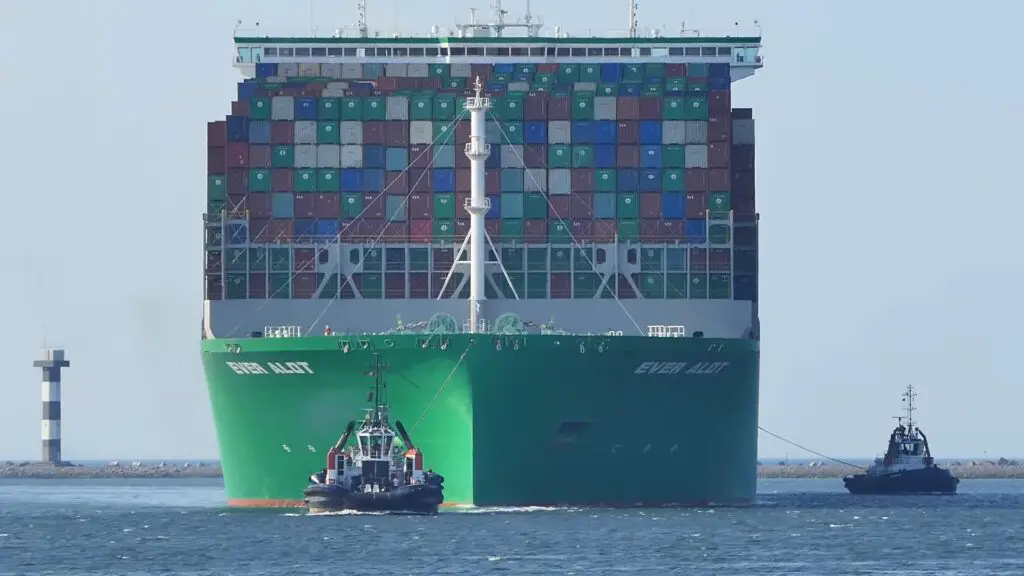
Glimpse into Evergreen Marine’s Titans
Evergreen Marine operates a fleet that includes some of the most impressive ships on the seas. The Ever A Lot, sailing under the flag of Panama, stands out in the Evergreen A-Class fleet.
These ships are technological marvels, capable of carrying nearly 24,000 twenty-foot equivalent units (TEUs), which doesn’t quite clinch the title for highest capacity but certainly places them among the top contenders.
The Ever A Lot’s Notable Features
The dimensions of the Ever A Lot are awe-inspiring, stretching 1,312 feet in length and spanning 202 feet across. Her draft reaches to 56 feet, enabling her to transport an array somewhere between 23,990 and 24,202 containers.
Fully loaded, she can bear the equivalent weight of 24 Eiffel Towers. Dual bow thrusters enhance the ship’s agility at lower speeds, while the heart of the ship, the Win GD 11X92B main engine, generates a remarkable 79,500 horsepower, letting her cruise at a brisk 22.5 knots.
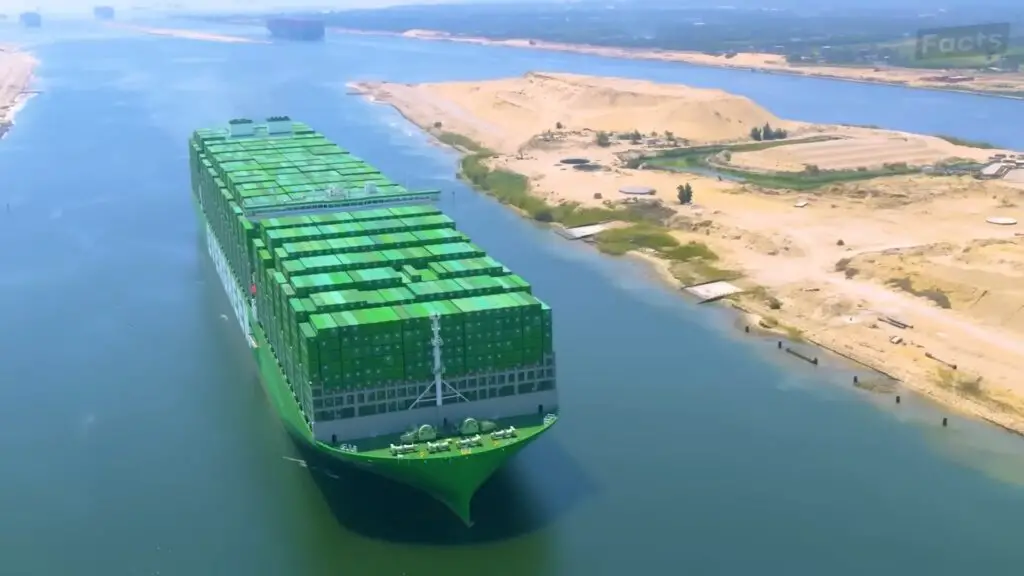
Record-Setting Ocean Voyages
Breaking records, the Evergreen Marine Class A vessel marked its place in history with the most containers on a route from Yantian to Europe. The significant voyage saw the ship loaded with an astounding 23,000+ TEUs.
Such feats not only demonstrate the ship’s capacity but also signify the advancement in maritime logistics and capabilities.
Investment and Production Costs
Building such titans of the sea comes with considerable cost. To illustrate, the creation of the Ever A Lot was contracted at around $145 million. Meanwhile, the Ever Ace had a price tag of about $150 million when contracted in 2019.
The shipyard of CSSC in China and Samsung Heavy Industries in South Korea took on the task of constructing 13 of these ships for Evergreen Marine, advancing the shipping industry’s possibilities with every new vessel completed.
Vessel Configuration and Attributes
Size Specifications
The gargantuan “Ever A Lot” marvels with its considerable length of 1,312 feet and a width of 202 feet, accompanied by a draft of 56 feet. This staggering configuration equips it with the capability to house a load ranging from 23,990 to 24,204 containers, the total weight of which can soar up to 240,000 tons.
Crew Quarters and Vessel Layout
Positioned amidships is the central accommodation bridge, flanked by two lifeboats on each side, which serves as the living quarters for the crew.
The vessel boasts nine decks, each serving distinct functions:
- Monkey Island for observation
- Navigation Bridge with all necessary controls and systems
- H Deck for electrical systems
- Accommodating spaces on Decks F, E, and D
- Recreational facilities on C Deck
- Food-related amenities on B Deck
- Emergency services on A Deck
- Personal storage on the U Deck
Streamlining and Energy Efficiency
Innovative hydrodynamic optimization technology is utilized to enhance the vessel’s speed without compromising fuel efficiency, leading to a harmonious blend of high performance and environmental consciousness.
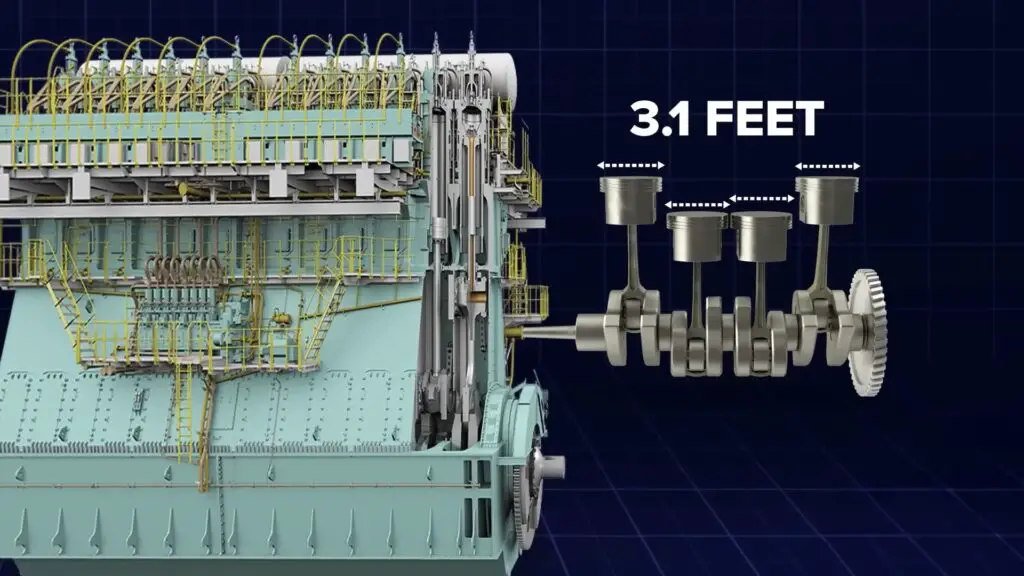
Engine Power and Performance
The powerful WinGD 11X92B main engine is the heart of its operation, delivering a formidable 58,600 KW or approximately 79,500 horsepower. This engine’s sheer might propels the vessel forward at an approximate speed of 22.5 knots.
Pistons within this engine span an impressive 3.1 feet in diameter, rivaling the world record for the largest engine pistons, illustrating the engine’s imposing scale.
CMA CGM Jacques Saadé: A Pioneer in LNG-Powered Maritime Innovation
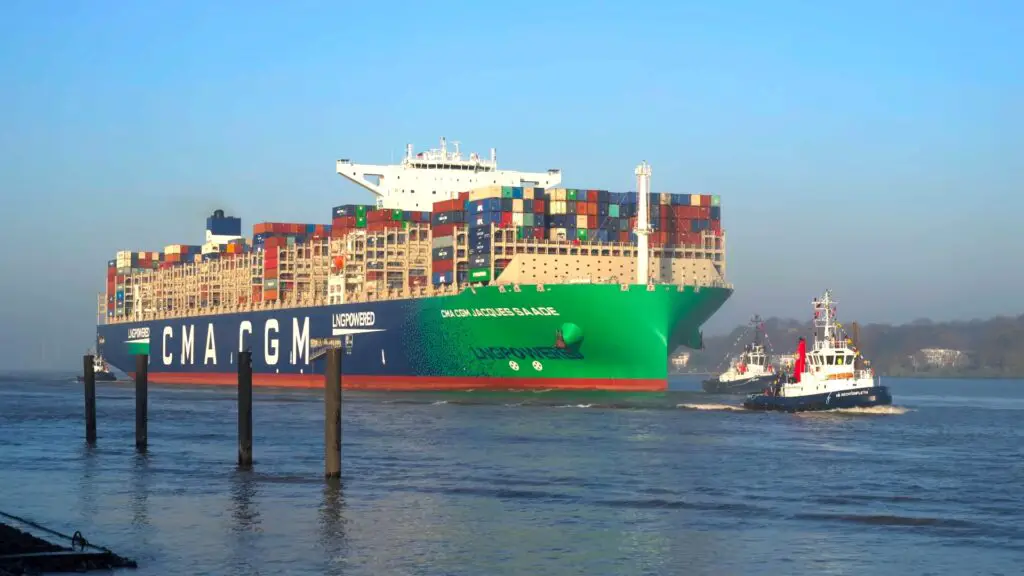
Birth of the Jacques Saadé Class Vessel
In 2020, the French shipping company CMA CGM introduced a groundbreaking marine craft, the Jacques Saadé, which stood out as the largest container ship fueled by liquefied natural gas (LNG) at the time.
A 23,400 nautical mile range without refueling and a capacity of 23,000 twenty-foot equivalent units (TEUs) underlined its operational prowess.
The entire structure was meticulously built around a colossal 660,000 cubic feet fuel tank designed to keep LNG at -161 degrees Celsius, incorporating state-of-the-art insulation measures.
This vessel’s unveiling marked a significant milestone, realized through elaborate part-wise assembly and rigorous quality assurance protocols.
LNG’s Environmental Advantages
In choosing LNG as the fuel source, CMA CGM demonstrated a commitment to reducing the maritime industry’s ecological footprint.
LNG propels the shipping sector towards a less polluting future by emitting 20% less carbon dioxide, nearly 99% fewer sulfur oxides, 92% less nitrogen oxide, and 91% fewer fine particulate matters compared to conventional marine fuels.
As the cleanest fossil fuel, LNG paves the way for vessels like the Jacques Saadé to advance towards zero-emission goals inherent in the environmental directives guiding contemporary shipping practices.
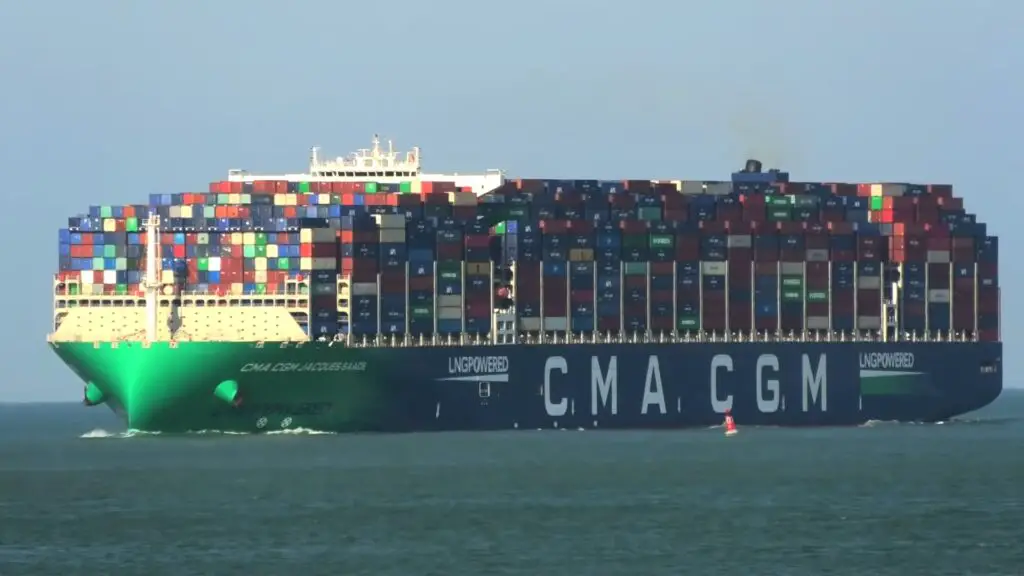
The Might of LNG-Fueled Propulsion
The Jacques Saadé introduced to the world the most formidable LNG engine ever installed on a container vessel—the Wärtsilä-designed 12X92DF.
This engineering marvel generates 63,800 kilowatts of power, akin to the force of 60 wind turbines or ten Airbus A380 jet engines.
Its assembly, a marvel of engineering in itself, required a precise construction process and thorough testing to ensure the highest levels of performance and reliability.
The result? A propulsion system that allows the vessel to sail at 22.5 knots while optimizing fuel consumption through advanced hydrodynamic technology.
Maritime Freight Capabilities and Key Figures
Vessel Hold Capacity – Jacques Saadé
The Jacques Saadé has a noteworthy cargo-holding prowess, characterized by its ability to transport a significant number of Twenty-foot Equivalent Units (TEUs).
This vessel, standing among the giants of the sea, boasts a length of 400 meters (1,312 feet) and a breadth of 61 meters (200 feet). It is engineered to accommodate approximately 23,112 TEUs.
When discussing its dimensions, it’s important to highlight that its substantial beam extends longer than an American football field and the length, a staggering four football fields combined. This is only marginally shorter than the Nimitz class aircraft carriers, emphasizing its colossal scale.
- Length:
400 meters (1,312 feet) - Beam (Width):
61 meters (200 feet) - TEU Capacity:
Approx. 23,112
Economic Investment and Development Period
The Jacques Saadé, a flagship marvel in maritime freight, represents a significant investment into the realm of cargo transportation.
French shipping company CMA CGM made a substantial financial commitment of $1.2 billion for the development and construction of nine identical sister ships. This investment averages to around $133 million for each vessel.
Regarding the timeline, the ship’s construction commenced in 2018, with approximately 14 months dedicated to assembly prior to the commencement of service in September 2020. The extensive sea trials that followed were crucial in ensuring the operational reliability of the vessel.
- Investment for Fleet:
$1.2 billion for nine sister ships - Cost per Vessel:
$133 million - Construction Start:
2018 - Service Commencement:
September 2020
